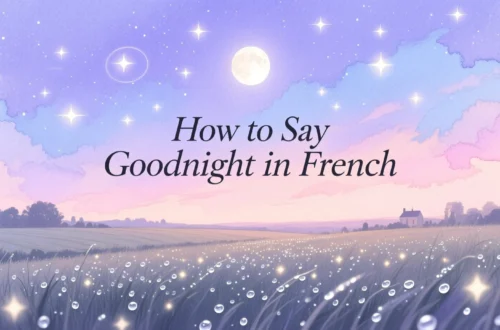As a child, I imagined fairies dancing in the moonlight, inspired by stories of delicate creatures with shimmering wings. The word “fairy” evokes wonder, yet its expression varies across cultures, each adding its own magical twist.
From a whispered “hada” in a Spanish village to a reverent “pari” in an Indian forest, the term for “fairy” captures humanity’s shared love for enchantment, shaped by unique traditions.
Let’s embark on a global journey to explore how people name these mystical beings and what their words reveal about cultural beliefs in magic.
Reference Table: “Fairy” in Different Languages
| Language | Word/Phrase | Cultural/Linguistic Insight |
|---|---|---|
| French | Fée | Evokes elegant, magical beings in folklore, like those in Perrault’s tales. |
| Spanish | Hada | Suggests ethereal creatures tied to nature and enchantment. |
| Italian | Fata | Linked to fate, reflecting fairies’ role in destiny in Italian stories. |
| German | Fee | Connected to ancient myths of forest spirits, gentle yet powerful. |
| Mandarin | Xiān nǚ (仙女) | Means “immortal woman,” tied to celestial beings in Chinese mythology. |
| Hindi | Pari | Refers to angelic, winged beings in Indian folklore, often benevolent. |
| Japanese | Yōsei (妖精) | Means “bewitching spirit,” blending beauty and mystery in tales. |
| Korean | Seonnye (선녀) | Refers to heavenly maidens in Korean myths, linked to nature. |
| Arabic | Jinnīya (جنية) | A female jinn, often magical but sometimes mischievous, in 20+ countries. |
| Swahili | Jini | A spirit or magical being, rooted in East African folklore. |
| Zulu | Ingane yezulu | Means “child of the sky,” evoking celestial magic in South Africa. |
| Yoruba | Iwin | A spirit tied to nature, often benevolent in Nigerian tales. |
| Maori | Patupaiarehe | Ethereal forest beings in New Zealand, tied to mist and music. |
| Hawaiian | Kupua | Shape-shifting magical beings, central to Hawaiian mythology. |
| Cherokee | Yunwi Tsunsdi | “Little people,” mischievous yet wise spirits in Native American lore. |
European Languages: Enchantment Woven in Folklore
European languages paint “fairy” with a blend of whimsy and mystique. For instance, in French, “fée” conjures images of elegant beings from Charles Perrault’s fairy tales, often granting wishes in enchanted forests. Meanwhile, Spanish uses “hada,” a term tied to nature’s magic, found in stories of delicate creatures guarding rivers. Additionally, Italian’s “fata” connects to fate, as fairies in Italian folklore often guide destinies, like in tales of the Befana. In German, “Fee” evokes ancient forest spirits, blending gentleness with power, as seen in Grimm’s tales. Thus, European terms reflect a shared love for magical narratives, from France’s poetic charm to Germany’s grounded mysticism.
Asian Languages: Celestial and Mystical Beings
Asia’s diverse languages offer enchanting terms for “fairy,” often tied to celestial or spiritual realms. For example, in Mandarin, “xiān nǚ” (immortal woman) refers to ethereal beings in Chinese mythology, like the moon goddess Chang’e. In Hindi, “pari” describes angelic, winged creatures in Indian folklore, often protectors in tales told under starry skies. Similarly, Japanese uses “yōsei” (bewitching spirit), evoking mysterious beings in Shinto-inspired stories. In Korean, “seonnye” (heavenly maiden) reflects myths of celestial women tied to nature, like those in the tale of the Woodcutter and the Fairy. Finally, Arabic’s “jinnīya,” used across over 20 countries like Egypt and Iraq, describes a female jinn, blending magic with mischief. These terms highlight Asia’s range, from divine elegance to enigmatic spirits.
African Languages: Spirits of Nature and Community
In African languages, “fairy” often connects to nature and spiritual lore. For instance, Swahili, spoken in over 20 countries like Kenya and Tanzania, uses “jini” for magical spirits, often tied to Islamic and local folklore. In Zulu, “ingane yezulu” (child of the sky) evokes celestial beings in South African tales, symbolizing divine protection. Similarly, Yoruba’s “iwin” in Nigeria refers to nature spirits, often benevolent guardians in stories shared at communal gatherings. These terms, used across diverse African settings, emphasize spiritual connections to the land and community, often celebrated in oral traditions.
Indigenous & Island Languages: Mystical Guardians of Tradition
Indigenous and island languages describe “fairy” with deep ties to nature and ancestry. For example, Maori in New Zealand uses “patupaiarehe,” ethereal forest beings linked to mist and music, revered in oral lore. In Hawaiian, “kupua” refers to shape-shifting magical beings, central to myths of gods and heroes. Similarly, Cherokee’s “yunwi tsunsdi” (little people) describes mischievous yet wise spirits in Native American stories, guarding sacred lands. In Samoan, terms like “aitu” (spirit) evoke supernatural beings tied to the Pacific’s communal traditions. Across these cultures, from New Zealand to the Cherokee Nation, “fairy” signifies mystical protectors, often honored in rituals.
Cultural Insights: The Evolution of Magical Beings
Words for “fairy” have evolved with cultural beliefs in the supernatural. For instance, the French “fée” traces back to Latin “fata” (fate), shaping medieval European tales. In Arabic, “jinnīya” stems from pre-Islamic jinn lore, blending magic with spirituality. Moreover, in African traditions, terms like “jini” reflect trade-era exchanges with Arabic cultures, tying spirits to local landscapes. In Asia, “xiān nǚ” and “pari” draw from ancient myths of celestial beings, shaped by religious philosophies like Taoism and Hinduism. These words carry histories of storytelling, from European castles to Pacific islands, uniting humanity’s fascination with the magical.
Proverbs and Sayings: Wisdom of Enchantment
- French: “Les fées dansent là où le cœur rêve.” (Fairies dance where the heart dreams.) – Ties magic to imagination.
- Hindi: “Pari ka sparsh dil ko sukoon deta hai.” (A fairy’s touch brings peace to the heart.) – Reflects benevolence.
- Swahili: “Jini huleta baraka kwa wale wanaowaamini.” (Spirits bring blessings to those who believe.) – Emphasizes faith.
- Japanese: “Yōsei wa yoru no yume ni sumu.” (Fairies live in the dreams of the night.) – Evokes mystery.
- Yoruba: “Iwin n sọrọ, ilẹ gbọ.” (When spirits speak, the earth listens.) – Connects fairies to nature.
FAQs
Why do some words for “fairy” sound similar?
Shared linguistic roots (e.g., Latin “fata” in French and Italian) and cultural exchanges (e.g., Arabic’s influence on Swahili) create similarities.
What’s the oldest term for “fairy”?
Latin “fata” (circa 1st century BCE), meaning “fate,” is among the earliest, evolving into modern European terms like “fée” and “fata.”
How do cultures shape the term’s use?
In spiritual cultures (e.g., African, Indigenous), fairies are tied to nature and ancestry, while European tales emphasize whimsy and destiny.
Conclusion
From “hada” in Spain to “jini” in Tanzania, the word for “fairy” weaves a global tapestry of wonder and magic. Each term, whether the celestial “xiān nǚ” in Mandarin or the misty “patupaiarehe” in Maori, reflects cultural beliefs while celebrating humanity’s shared enchantment. Consequently, these words remind us that magic, in all its forms, unites people across the globe. How do you say “fairy” in your language, and what stories does it inspire? Share your thoughts below—we’d love to hear your magical tales!





